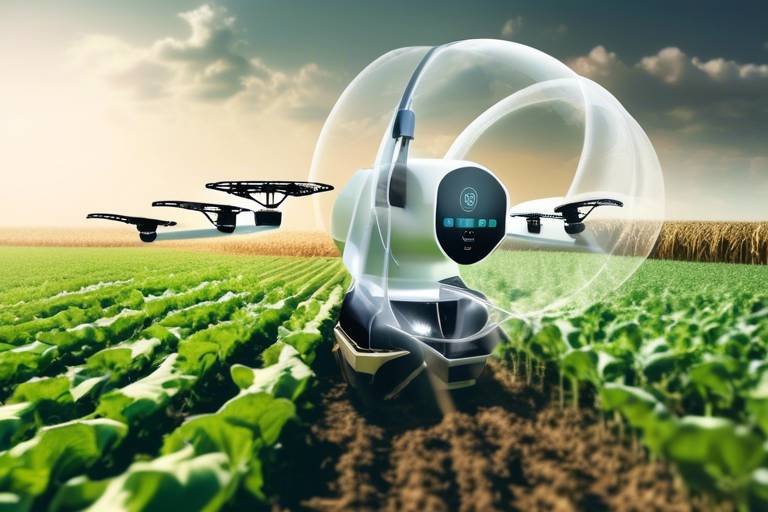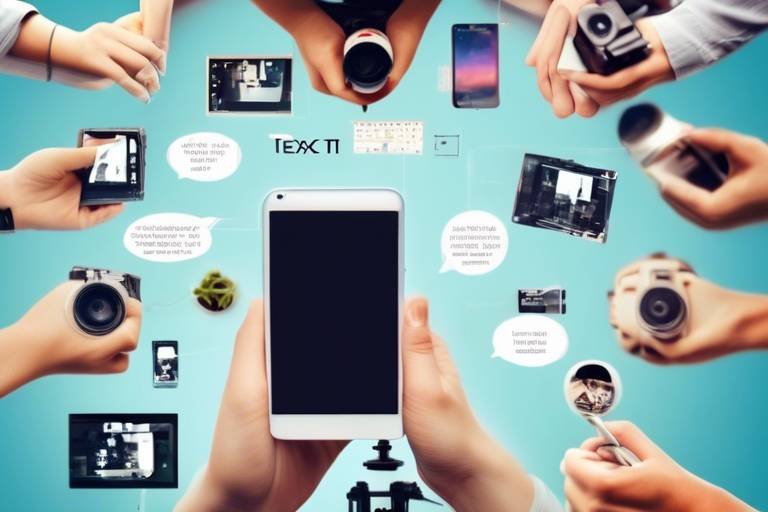The Future of Holographic Technology in Communication
Imagine a world where communication transcends the limitations of traditional screens, where conversations feel as if they are happening face-to-face, regardless of the distance. This is not just a sci-fi dream; it’s the potential reality brought forth by holographic technology. As we stand on the brink of this technological revolution, it’s essential to explore how holography can redefine the way we interact, both personally and professionally. From the realms of entertainment to the corridors of corporate offices, holographic communication is set to change the game in ways we can only begin to fathom.
Currently, holographic technology is making waves in various fields, including entertainment, education, and telecommunications. For instance, in the entertainment industry, holograms are used to create stunning live performances, allowing artists to engage with their audiences in unprecedented ways. In education, holographic displays can transform complex subjects into interactive experiences, making learning not just informative but also engaging. The telecommunications sector is also leveraging this technology to enhance communication efficiency, paving the way for a future where distance is no longer a barrier.
As we delve deeper into this fascinating topic, we will uncover the latest advancements in holographic displays that are making immersive communication possible. Recent breakthroughs have improved visual quality and accessibility, allowing users to experience holograms that are not only lifelike but also easy to interact with. One of the most exciting developments is 3D holographic telepresence, which enables users to interact with life-sized holograms of their colleagues or friends. This technology has the potential to revolutionize remote work and virtual meetings, creating an atmosphere that feels much more engaging than a typical video call.
Furthermore, the impact of holographic technology on remote collaboration cannot be overstated. Imagine a team spread across different continents working together in real-time, sharing holographic images and ideas as if they were in the same room. This level of interaction can significantly enhance productivity and creativity, making it easier for teams to brainstorm and innovate.
In the realm of education, the possibilities are equally exciting. Holographic technology can facilitate interactive learning experiences, allowing students to visualize complex concepts in a way that textbooks simply cannot match. For example, a biology class could use holograms to explore the human body in 3D, making learning more intuitive and memorable.
However, despite its immense potential, several challenges hinder the widespread adoption of holographic communication. Technical limitations, high costs, and social barriers need to be addressed to make this technology accessible to everyone. As we look ahead to the future trends in holographic technology, we will explore how innovations in artificial intelligence and augmented reality could further enhance these communication tools. The convergence of these technologies promises to create new synergies, making holographic communication even more powerful.
The market for holographic technology is expected to experience significant growth in the coming years. This presents exciting opportunities for businesses and investors alike. As we analyze market trends and forecasts, it becomes clear that the future of holographic communication is not just a possibility; it’s an impending reality that we must prepare for.
- What is holographic technology? Holographic technology refers to the creation of three-dimensional images that can be viewed without the need for special glasses, allowing for a more immersive experience.
- How is holographic technology used in communication? It enhances communication by allowing users to interact with life-sized holograms, making conversations feel more personal and engaging.
- What are the potential applications of holographic technology? Applications include teleconferencing, education, entertainment, and remote collaboration.
- What challenges does holographic technology face? Challenges include technical limitations, high costs, and the need for widespread adoption.
- How will holographic technology evolve in the future? Future trends include integration with AI and AR, enhancing user experience and creating new communication opportunities.

Current Applications of Holographic Technology
Holographic technology is not just a concept from science fiction; it's already making waves in various fields, transforming how we interact and communicate. In the realm of entertainment, holograms have become a captivating way to enhance live performances. Imagine attending a concert where your favorite artist appears as a lifelike hologram, creating an immersive experience that feels almost magical. This technology doesn't just stop at concerts; it extends to theater productions and even theme parks, where holograms can bring stories to life in ways that traditional media simply cannot.
In the education sector, holographic technology is revolutionizing the way students learn. Picture a classroom where complex scientific concepts are illustrated through interactive 3D models, allowing students to visualize and manipulate the subject matter. This approach not only enhances understanding but also keeps students engaged. For example, medical students can study anatomy with holographic representations of human organs, providing a hands-on learning experience that textbooks alone cannot offer.
Moreover, the field of telecommunication is experiencing a significant shift thanks to holographic technology. Video calls are becoming more dynamic with the introduction of holographic avatars that can represent individuals in a three-dimensional space. This innovation allows for a more personal touch in remote communication, making conversations feel more natural and engaging. Imagine discussing a project with a colleague who appears as a life-sized hologram in your living room—it's a game-changer for both personal and business interactions.
The applications of holographic technology extend beyond entertainment and education. In the medical field, surgeons are utilizing holograms to visualize patient anatomy during procedures, allowing for greater precision and improved outcomes. This technology is also being explored in marketing, where businesses are using holographic displays to create eye-catching advertisements that draw in customers. The potential is vast, and as technology continues to advance, we can expect to see even more innovative uses for holograms in our daily lives.
To summarize, the current applications of holographic technology are vast and varied. Here’s a quick overview of some key areas where holograms are making an impact:
| Field | Application |
|---|---|
| Entertainment | Live performances, concerts, and theme park attractions |
| Education | Interactive learning experiences, 3D anatomy models |
| Telecommunication | Holographic video calls and remote meetings |
| Healthcare | Visualizing patient anatomy for surgeries |
| Marketing | Eye-catching holographic advertisements |
As we delve deeper into the potential of holographic technology, it's clear that its current applications are just the tip of the iceberg. The way we communicate, learn, and interact is on the verge of a monumental shift, and the future looks incredibly bright.

Advancements in Holographic Displays
The world of holographic displays is evolving at a breakneck speed, bringing us closer to a future where communication transcends traditional boundaries. Imagine a world where you can not only see but also interact with life-sized holograms of your friends, colleagues, or even historical figures! Recent advancements in this technology are not just enhancing visual fidelity; they are also making these experiences more accessible and user-friendly.
One of the most exciting developments is the improvement in resolution and clarity. Holographic displays are now capable of producing images that are not only vibrant but also incredibly detailed. This is largely due to innovations in light field technology, which allows for the creation of images that appear three-dimensional from multiple angles. Users can move around the display, and the holograms will adjust accordingly, creating a truly immersive experience.
Another significant advancement is the reduction in the size and cost of holographic display devices. In the early stages of this technology, high-quality holographic displays were bulky and prohibitively expensive, limiting their use to specialized industries. However, with ongoing research and development, manufacturers are now producing compact and affordable devices that can be utilized in everyday settings, such as homes and offices. This democratization of technology means that soon, we might all have access to holographic communication tools that were once the stuff of science fiction.
Furthermore, the integration of augmented reality (AR) with holographic displays is opening up new avenues for interaction. Users can overlay digital content onto the real world, enhancing their communication experience. For instance, during a business meeting, a holographic display can project a 3D model of a product, allowing team members to explore its features in real-time. This blend of AR and holography not only makes presentations more engaging but also aids in better understanding and retention of information.
Moreover, the advancements in user interface (UI) design for holographic displays are making them more intuitive. Gesture recognition technology allows users to interact with holograms using simple hand movements. Imagine swiping your hand to navigate through a presentation or pinching to zoom in on a holographic image. This level of interactivity makes communication more fluid and natural, reducing the barriers often associated with traditional touchscreen interfaces.
To sum it up, the advancements in holographic displays are paving the way for a future where communication is more engaging, interactive, and accessible. As these technologies continue to develop, we can expect to see a surge in their applications across various sectors, transforming the way we connect with one another.
- What are holographic displays? Holographic displays are advanced visual technologies that create three-dimensional images, allowing users to see and interact with them from various angles.
- How do holographic displays work? They use light field technology to project images that appear three-dimensional, creating a sense of depth and realism.
- What are the applications of holographic displays? Holographic displays have applications in entertainment, education, healthcare, and business, enhancing communication and learning experiences.
- Are holographic displays expensive? While they were once costly, ongoing advancements are making them more affordable and accessible for everyday use.

3D Holographic Telepresence
The concept of is nothing short of revolutionary. Imagine being able to interact with a life-sized hologram of your colleague, friend, or even a loved one, as if they were standing right in front of you. This technology is not just a figment of science fiction; it's becoming a reality and is set to transform how we communicate across distances. By utilizing advanced holographic displays, users can engage in conversations that feel incredibly real and immersive, bridging the gap that traditional video calls simply cannot.
What makes 3D holographic telepresence so compelling? For starters, it enhances the human connection. In a world where remote work and virtual meetings have become the norm, the ability to see someone as a three-dimensional image adds a layer of presence that flat screens can't replicate. It's akin to stepping into a sci-fi movie where characters interact in a shared space, despite being miles apart. This technology can create a more engaging environment, making discussions more productive and meaningful.
Furthermore, 3D holographic telepresence can significantly impact various sectors, especially in business and education. For instance, consider a scenario where a team of engineers from different parts of the globe collaborates on a project. Instead of merely sharing screens or sending emails, they can gather around a holographic model of their design, discussing modifications in real-time. This not only fosters creativity but also enhances teamwork, as members can point to specific elements, ask questions, and brainstorm solutions collectively.
In educational settings, the benefits are equally remarkable. Imagine students being able to attend a virtual lecture where their professor appears as a hologram, walking around the classroom, demonstrating concepts in 3D, and even interacting with students. Such an immersive learning experience can captivate students' attention and improve retention of complex subject matter. The possibilities are endless, and as this technology continues to advance, we can expect to see more innovative applications in both professional and educational contexts.
However, the journey to widespread adoption of 3D holographic telepresence isn't without its challenges. Technical limitations, such as the need for high-speed internet and advanced display equipment, can be hurdles for many organizations. Additionally, the cost of implementing such technology can be prohibitive for smaller businesses or educational institutions. Yet, as with any emerging technology, these barriers are likely to diminish over time as advancements are made and costs decrease.
In summary, 3D holographic telepresence is poised to redefine communication by making interactions more lifelike and engaging. Whether in a boardroom or a classroom, the ability to connect with others in a three-dimensional space opens up new avenues for collaboration and learning. As we continue to explore its potential, one thing is clear: the future of communication is looking incredibly bright and immersive.
- What is 3D holographic telepresence?
It is a technology that allows users to interact with life-sized holograms, creating a more immersive communication experience. - How can it benefit businesses?
It enhances collaboration, making virtual meetings more engaging and productive by allowing team members to interact with 3D models in real-time. - Is this technology accessible to everyone?
While it has great potential, current limitations in technology and cost may restrict access for some users. - What industries can benefit from this technology?
Industries such as education, healthcare, and engineering can significantly benefit from 3D holographic telepresence.

Impact on Remote Collaboration
The rise of holographic technology is set to redefine how we collaborate remotely. Imagine being able to sit across the table from a life-sized hologram of your colleague, discussing projects as if they were right there with you. This innovative approach to communication bridges the gap created by distance, making remote collaboration feel more personal and immersive than ever before. It’s like stepping into a sci-fi movie where the boundaries of reality blur, allowing for a richer exchange of ideas and creativity.
One of the most significant advantages of holographic communication is the ability to share 3D visualizations in real-time. This feature is especially beneficial in industries that rely heavily on visual data, such as architecture and engineering. For instance, when discussing a new building design, team members can manipulate and view the project from different angles, providing immediate feedback and fostering a dynamic brainstorming environment. It’s akin to having a virtual whiteboard that everyone can interact with, regardless of their physical location.
Moreover, holographic technology can enhance the emotional connection between team members. When we see someone’s facial expressions and body language, it adds layers of understanding to our conversations that are often lost in traditional video calls. This can lead to stronger relationships and improved team dynamics. In fact, studies have shown that teams that feel more connected are not only more productive but also more innovative. Therefore, the integration of holographic communication could be a game-changer for companies looking to boost morale and collaboration.
However, the impact of holographic collaboration extends beyond just interpersonal interactions. It also allows for more effective problem-solving. Teams can gather around a holographic model to dissect issues, brainstorm solutions, and visualize outcomes in a way that static images or screens simply cannot match. This hands-on approach can accelerate the decision-making process and lead to more informed choices. In a world where speed and efficiency are paramount, holographic technology could provide the competitive edge that businesses need.
In summary, the impact of holographic technology on remote collaboration is profound. By creating a more engaging and interactive environment, it not only enhances communication but also fosters stronger relationships among team members. As we embrace this technology, we can expect to see a shift in how teams operate, leading to increased productivity and innovation.
- What is holographic technology? Holographic technology creates three-dimensional images that can be viewed without the need for special glasses, allowing for immersive experiences in various applications.
- How does holographic communication improve remote collaboration? It allows users to interact with life-sized holograms, enhancing emotional connections, real-time sharing of visual data, and fostering a more engaging collaborative environment.
- What industries can benefit from holographic technology? Industries such as architecture, engineering, education, and healthcare can leverage holographic technology for better visualization, training, and remote consultations.
- Are there challenges to adopting holographic technology? Yes, challenges include technical limitations, high costs, and the need for widespread acceptance among users.

Applications in Education
Imagine walking into a classroom where the walls are alive with vibrant holograms, bringing lessons to life in ways that textbooks simply can't. Holographic technology is set to revolutionize education by providing interactive and immersive learning experiences. This technology allows students to visualize complex concepts, making learning not just informative but also engaging and fun.
For instance, in subjects like biology, students can explore the human body in three dimensions, examining organs and systems from all angles. Instead of merely reading about the heart's functions, they can interact with a holographic model, understanding its structure and operation in real-time. This hands-on approach fosters a deeper understanding and retention of knowledge.
Furthermore, holographic technology can facilitate remote learning. Imagine a scenario where students from various locations can attend a virtual class together, interacting with a holographic instructor who can demonstrate experiments or concepts live. This not only breaks geographical barriers but also enhances collaboration among students. They can work together on projects, share ideas, and learn from each other in a dynamic environment that feels almost tangible.
Moreover, the use of holograms in education can cater to different learning styles. Visual learners benefit from seeing content presented in three dimensions, while kinesthetic learners can engage with holographic simulations that require active participation. This adaptability ensures that every student has the opportunity to learn in a way that suits them best.
As we look to the future, it’s clear that the integration of holographic technology in education will not be without its challenges. Schools will need to invest in the necessary infrastructure and training for teachers. However, the potential rewards are immense. By creating an engaging and interactive learning environment, we can inspire a new generation of learners who are not only knowledgeable but also excited about their education.
In summary, the applications of holographic technology in education are vast and varied. As this technology continues to evolve, it promises to create a more engaging, immersive, and effective learning experience for students around the globe.

Challenges Facing Holographic Communication
While the potential of holographic communication is nothing short of exciting, it’s crucial to recognize that this technology faces several significant challenges that could impede its widespread adoption. One of the primary hurdles is the technical complexity involved in creating and maintaining high-quality holographic displays. Unlike traditional video conferencing, which relies on standard cameras and screens, holographic technology requires advanced hardware and software to generate realistic 3D images. This complexity can lead to higher costs and a steeper learning curve for users.
Furthermore, the financial barriers associated with the development and implementation of holographic systems cannot be overlooked. For many businesses, especially small to medium enterprises, the initial investment in holographic technology can be prohibitively expensive. This includes not only the cost of the equipment but also the necessary infrastructure upgrades, such as faster internet connections and enhanced data storage solutions. As a result, many organizations may be hesitant to adopt this innovative technology until it becomes more affordable.
Another challenge is the social acceptance of holographic communication. People are creatures of habit, and transitioning from familiar forms of communication—like video calls and emails—to a holographic interface can be daunting. Users may feel uncomfortable or even skeptical about interacting with holograms, which could hinder adoption rates. Additionally, privacy concerns arise when sharing holographic images, as users might worry about how their data is being used or stored. Addressing these concerns is essential for promoting a smooth transition to holographic communication.
Moreover, the standardization of holographic technology poses a significant challenge. As various companies develop their own systems, the lack of universal protocols can lead to compatibility issues. Imagine trying to hold a meeting where some participants are using one type of holographic display while others are using a different system—communication would quickly become chaotic! Establishing industry standards is vital to ensure seamless interactions across different platforms.
In summary, while the future of holographic communication is bright, overcoming these challenges will be crucial for its success. The combination of technical, financial, and social barriers must be addressed to pave the way for a more interconnected and immersive communication landscape.
- What is holographic communication? Holographic communication refers to the use of holograms to facilitate real-time, interactive communication between users, creating a more immersive experience compared to traditional video conferencing.
- What are the main challenges of holographic communication? The primary challenges include technical complexity, financial barriers, social acceptance, and the need for standardization across different systems.
- How can businesses benefit from holographic communication? Businesses can enhance collaboration, improve remote meetings, and create engaging presentations, leading to increased productivity and innovation.
- Is holographic technology expensive? Currently, the costs associated with holographic technology can be high, but as the technology evolves and becomes more mainstream, prices are expected to decrease.

Future Trends in Holographic Technology
The future of holographic technology is brimming with potential, promising to reshape how we communicate, collaborate, and connect. As we stand on the cusp of this technological revolution, it’s essential to explore the emerging trends that will define the landscape of holographic communication. One of the most exciting avenues is the integration of artificial intelligence (AI) and augmented reality (AR) with holographic displays. Imagine a world where holograms not only project images but also analyze data and respond to user interactions in real time. This convergence could lead to a new era of immersive communication, where virtual assistants manifest as holograms, providing assistance in a more engaging and intuitive manner.
Furthermore, the market potential for holographic technology is staggering. Industry analysts predict that the holographic display market could reach $5 billion by 2025, driven by advancements in display technologies and increased demand across various sectors. Businesses are beginning to recognize the value of holographic presentations, which can captivate audiences far more effectively than traditional slideshows. This shift could lead to a surge in investment and development, making holographic communication a staple in corporate environments.
As we look ahead, it's crucial to consider how holographic technology will be adopted in everyday life. We might see holograms used in telemedicine, where doctors can consult with patients through life-sized projections, making remote healthcare more personal and effective. Additionally, the entertainment industry is poised to leverage this technology for concerts and events, allowing fans to experience performances as if they were physically present, regardless of their location.
However, the path to widespread adoption won't be without its hurdles. As holographic technology evolves, issues such as cost and accessibility will need to be addressed. The initial investment in holographic systems can be significant, potentially limiting access to larger corporations and affluent individuals. To overcome this, companies will need to innovate and create more affordable solutions that can reach a broader audience.
In conclusion, the future of holographic technology in communication is bright and full of possibilities. As we embrace these advancements, we should also remain mindful of the challenges that lie ahead. By addressing these issues collaboratively, we can pave the way for a more connected world where holographic communication enhances our daily interactions.
- What are holograms? Holograms are three-dimensional images created using light patterns that can be viewed from different angles.
- How is holographic technology used in communication? Holographic technology enhances communication by allowing users to interact with life-sized, three-dimensional representations during meetings and presentations.
- What industries can benefit from holographic technology? Holographic technology can benefit various industries, including healthcare, education, entertainment, and corporate sectors.
- Are there any challenges to adopting holographic technology? Yes, challenges include high costs, technical limitations, and the need for widespread infrastructure to support its use.
- What does the future hold for holographic communication? The future looks promising, with trends pointing towards integration with AI and AR, increased market growth, and more accessible technology.

Integration with AI and AR
The fusion of holographic technology with artificial intelligence (AI) and augmented reality (AR) is set to create a new frontier in communication that many of us can only dream of today. Imagine a world where your holographic assistant not only appears in your living room but also understands your needs, anticipates your questions, and helps you navigate through complex tasks in real-time. This integration is not just a futuristic concept; it is rapidly becoming a reality, transforming how we interact with technology and each other.
At its core, the combination of these technologies enhances user experience by providing more intuitive and interactive interfaces. For instance, AI algorithms can analyze user behavior and preferences, allowing holographic displays to adapt and personalize the information presented. This means that rather than merely viewing a hologram, users can engage with it in a way that feels natural and tailored to their needs. Imagine having a holographic tutor who not only explains complex subjects but also adjusts its teaching style based on how you learn best.
Furthermore, the integration of AR adds another layer of depth to holographic communication. With AR, users can overlay digital information onto the real world, creating a seamless blend of physical and virtual experiences. For example, during a business meeting, participants could see holographic representations of data charts and graphs floating in the air, allowing for a more interactive discussion. This kind of immersive experience can significantly enhance understanding and retention of information, making meetings more productive and engaging.
However, the potential of integrating AI and AR with holographic technology is not limited to just enhancing personal interactions. In the business realm, it opens up new avenues for collaboration and innovation. Imagine a team spread across different continents working together on a project, where each member can interact with the same holographic model of a product, making real-time adjustments and suggestions. This kind of collaboration can lead to faster decision-making and a more cohesive team dynamic.
As we look to the future, the possibilities are vast. The combination of these technologies can lead to advancements in various sectors including healthcare, education, and entertainment. For instance, in healthcare, doctors could utilize holographic displays to visualize complex surgeries, aided by AI that provides real-time data and recommendations. In education, students might explore historical events through immersive holographic experiences that are enhanced by AI-driven narratives.
In summary, the integration of holographic technology with AI and AR is not just a trend; it represents a fundamental shift in how we communicate and interact with the world around us. As these technologies continue to evolve, they promise to create more engaging, efficient, and personalized communication experiences that could redefine our daily lives.
- What is holographic technology? Holographic technology uses light to create three-dimensional images that can be viewed without special glasses, allowing for immersive visual experiences.
- How does AI enhance holographic communication? AI can personalize interactions by analyzing user behavior and preferences, making holographic displays more intuitive and responsive.
- What role does AR play in holographic technology? AR overlays digital information onto the real world, enriching the holographic experience by blending physical and virtual elements.
- What are the potential applications of these integrated technologies? Potential applications include enhanced remote collaboration, immersive education experiences, and advanced healthcare visualizations.

Market Potential and Growth
The holographic technology market is on the brink of a significant transformation, with projections indicating an explosive growth trajectory in the coming years. As businesses and consumers alike begin to recognize the benefits of holographic communication, the demand for innovative solutions will only escalate. According to recent studies, the global holographic display market is expected to reach an astonishing $5.5 billion by 2025, growing at a compound annual growth rate (CAGR) of over 30%. This surge is fueled by advancements in technology and increasing applications across various industries.
One of the primary drivers of this growth is the rising interest in immersive experiences. Companies are eager to adopt holographic technology to enhance customer engagement and create memorable interactions. Imagine walking into a store and seeing a life-sized hologram of a product, demonstrating its features in real-time! This kind of experience not only captures attention but also converts interest into sales. The retail sector is just one area where holographic technology can make a significant impact, but it doesn't stop there.
In sectors like healthcare, education, and entertainment, the potential applications are vast. For instance, in healthcare, holograms can be used for training medical professionals, allowing them to visualize complex procedures in a three-dimensional space. Similarly, in education, students can interact with holographic models of historical events or scientific phenomena, making learning more engaging and effective. As these industries begin to implement holographic solutions, the market will continue to expand exponentially.
Moreover, the integration of holographic technology with other cutting-edge innovations, such as artificial intelligence (AI) and augmented reality (AR), is set to create even more opportunities. The synergy between these technologies can lead to the development of sophisticated tools that enhance communication and collaboration. For instance, imagine a virtual meeting where participants can interact with 3D holograms of data visualizations, making discussions more interactive and productive.
However, it’s essential to note that the growth of the holographic market is not without its challenges. High costs associated with developing and implementing holographic solutions can deter businesses, particularly small and medium-sized enterprises. Additionally, there is a need for more widespread understanding and acceptance of this technology among users. Overcoming these barriers will be crucial for unlocking the full potential of holographic communication.
To summarize, the market potential for holographic technology is enormous, driven by its transformative capabilities across various sectors. As we look to the future, the convergence of holographic displays with AI and AR will likely redefine how we communicate, collaborate, and engage with each other. The next few years will be pivotal in determining how quickly and effectively this technology can permeate our daily lives.
- What industries are expected to benefit the most from holographic technology? Industries such as healthcare, education, retail, and entertainment are expected to see significant advantages from adopting holographic technology.
- What are the main challenges facing the holographic technology market? Key challenges include high implementation costs, technological limitations, and the need for user education and acceptance.
- How does holographic technology integrate with AI and AR? Holographic technology can work alongside AI and AR to create immersive experiences that enhance communication and collaboration, allowing users to interact with virtual elements in real-time.
Frequently Asked Questions
- What is holographic technology?
Holographic technology creates three-dimensional images or projections that can be viewed from different angles, giving an illusion of depth. This technology has applications in various fields, including communication, entertainment, and education.
- How is holographic technology currently used in communication?
Currently, holographic technology is used in video conferencing and virtual meetings, allowing participants to see life-sized holograms of each other. This enhances the feeling of presence and engagement, making remote interactions more personal and effective.
- What advancements have been made in holographic displays?
Recent advancements include improved visual quality, accessibility, and the ability to create more immersive environments. These developments are making it easier for users to experience and interact with holograms in real-time.
- What is 3D holographic telepresence?
3D holographic telepresence refers to the technology that allows users to interact with life-sized holograms, making remote work and virtual meetings feel more engaging and realistic. It transforms the way we connect with others, regardless of distance.
- What challenges does holographic communication face?
Some challenges include technical limitations, high costs of equipment, and social barriers such as user acceptance and familiarity with the technology. Addressing these issues is crucial for widespread adoption.
- How will holographic technology evolve in the future?
Future trends suggest that holographic technology will increasingly integrate with artificial intelligence and augmented reality, creating powerful new communication tools that can enhance user experiences and interactions.
- What is the market potential for holographic technology?
The market for holographic technology is expected to grow significantly, driven by advancements in technology and increasing demand across various sectors. This presents exciting opportunities for businesses and investors alike.



















